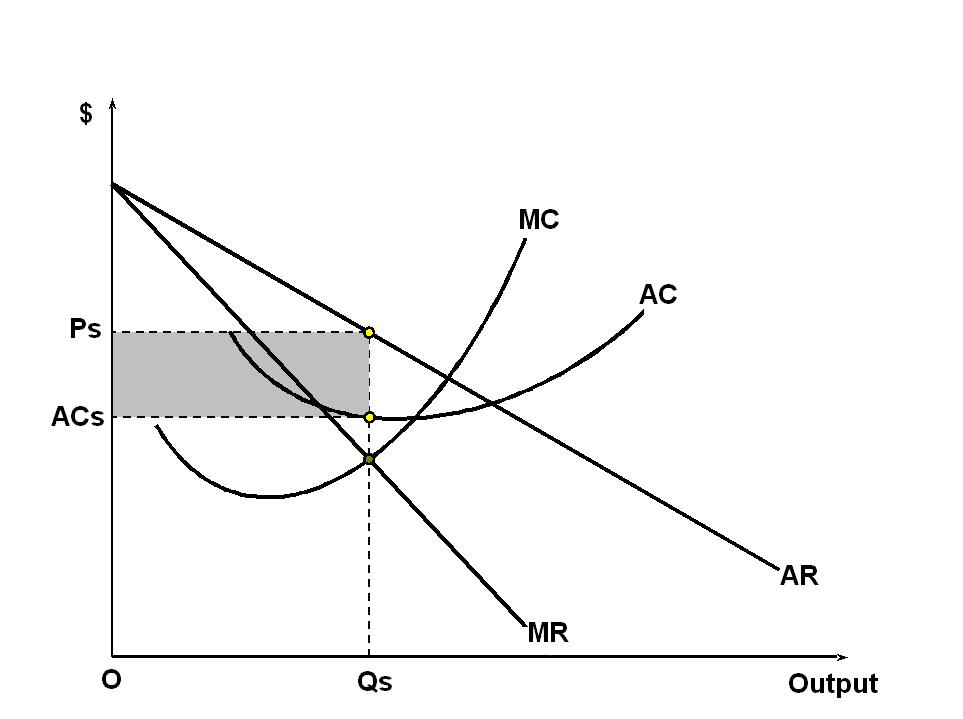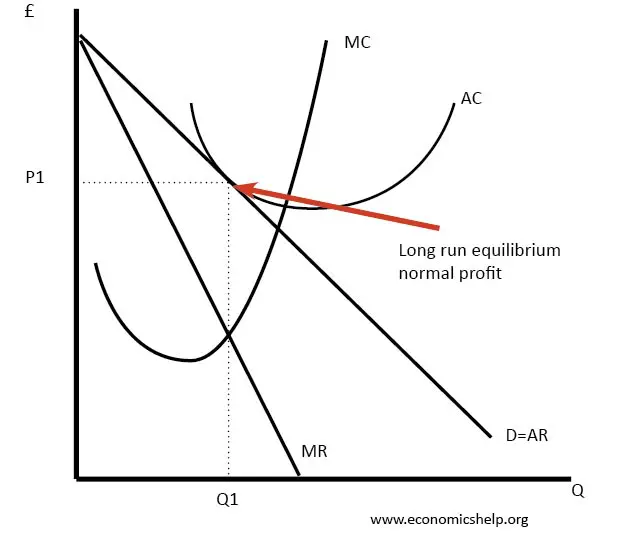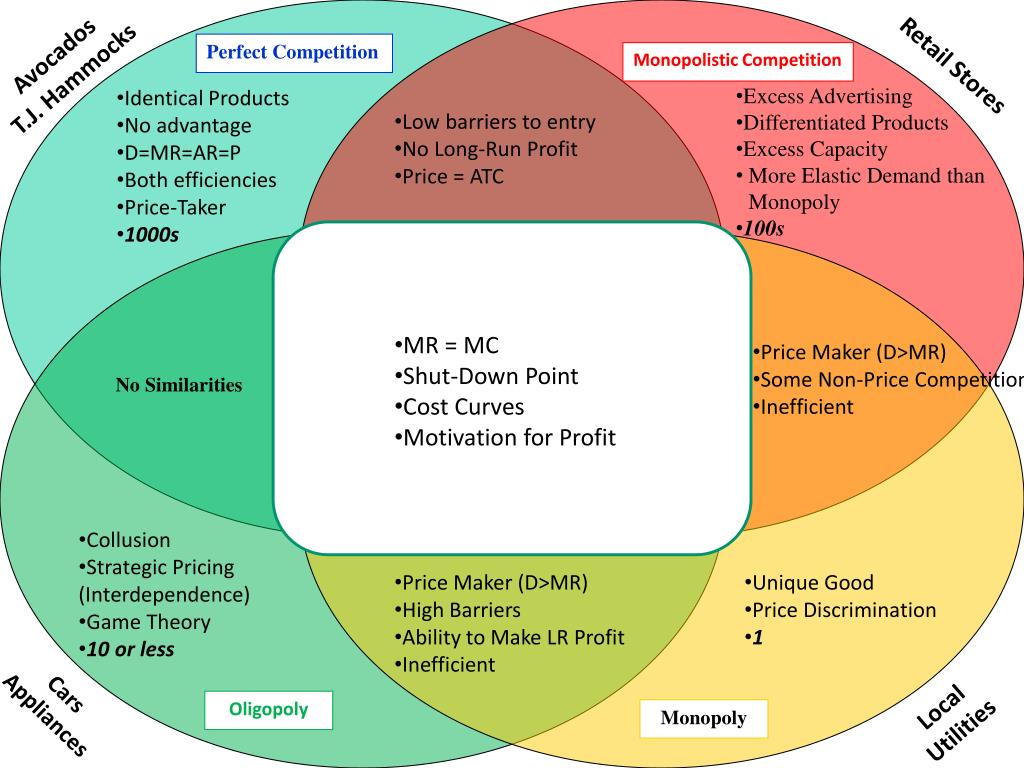
Ch 9 - Imperfect Competition: Monopolistic Competition and Oligopoly
(Microeconomics)
As we have seen before, perfect competition, monopolistic competition, oligopoly, and monopoly are known as the four market structures. Monopoly has the least competition, which perfect competition is the most competitive. Monopolistic competition is between imperfect and perfect competition, which Oligopoly is on Imperfect competition.
Efficiency and Monopolistic Competition
Monopolistic Competition: Firms in this market structure have characteristics of both a monopoly and perfect competition.
These firms sell their own products which are different than other competitors. This market is competitive due to easy entry and exit into the market, and the monopolistic firms have some monopoly over the market.
Characteristics of Monopolistic Competition
Inefficiency: monopolistically competitive firms are not allocatively efficient. P is unequal to MC, as price tends to be greater than MC. Similarly, these firms are not productively efficient since Price does not equal to minimum ATC.
Easy Entry and Exit: new firms are able to enter and exit the very easily so when new firms arrive, the demand decreases for other existing firms. When firms exit the market and substitutes decrease, demand also increases for the existing markets.
Differentiated Products and Nonprice Competition: non-price competition focuses on product promotion which set them apart from other rivals. Differentiated products are those which aim to set themselves apart from other firms as a way to increase demand for their products.
Zero Economic Profit in the Long Run: In the long run, economic profit will be decreased due to easy entry and exit.
Marginal Revenue < Demand: they are both downsloping in the monopoly diagram.
Monopolistic Competition in the Long and Short run:

As there is intense competitive environment in the short run, there will be dynamic shifts in demand. Firms will experience losses as they leave the firm, which will be the chance for other firms to gain access to higher demand.
In Fig.1, the firm earns economic profit in the short run, and as these profits increase, new opportunities are provided for new firms to enter the industry and gain profits.
In the long run, the firms who newly enter the market, these newer firms will see an opportunity to maximise profit and enter the market.
To Remember:
Monopolistically competitive firms encourage other firms to enter the market, however, this leads to a decrease in demand curve for existing firms. If the new firms experience losses, they will leave the market, and thus increasing the demand curve

As we can see in Fig 2, the shaded area from Ps to ACs is the economic loss experienced in the short term. This is where firms begin leaving the market when they fail. The triangle area from Qs is known as the deadweight loss, which decreases consumer surplus and the market’s economic surplus.

As we can see in the long run, the market will also experience a deadweight loss. the demand and marginal revenue shift to the right as well.
Efficiency and Monopolistic Competition
In Fig. 3, we can see that a monopolistically competitive firm in the long is neither defined as allocatively efficient (where price does not equal Marginal cost) nor productively efficient (where Price does not equal minimum ATC).
The deadweight loss produced at this point is not as large as a monopoly. A firm in monopolistic competition does not earn economic profits in the long run, however, it earns a normal profit.
Perfect Competition | Monopolistic Competition | |
|---|---|---|
Long-run profits | No economic profit, Profit = Minimum ATC | No economic profit, Price = ATC |
Efficiency/inefficiency | The market will isolate inefficient firms | inefficient (excess capacity) |
Product Differentiation | The products are identical to each other | Differentiation is essential for survival |
P and MC | P=MC, this indicates that there is an optimal distribution of resources | P>MC, the allocation of resources is inefficient |
P and MR | P=MR, All firms do not set their own prices, they take their prices from the market | P>MR, The firms set their own prices |
Excess Capacity
When the demand for a good or service is less than the amount of supply which the firm would provide to the market.
Monopolistic Competition:
Easy entry into the market
Differentiated and segregated products
Inefficient capacity
Large amount of buyers and sellers
In the long run, there are zero economic profits
There is inefficiency in the market, as price is greater than marginal costs
Marginal revenue is less than price
There is deadweight loss in the market
Introduction to Oligopoly
Oligopoly: In this case, a number of firms within the same industry are dominating the market. Due to constant competition between firms, this leads to less increases in price.
Collusion: is the illegal alliance of two opposing firms in an attempt to disrupt market equilibrium. In an attempt to retaliate against this, an antitrust policy has been implemented. This policy aims to prevent the creation of oligopolies from developing into monopolies as the lack of competition is not good for the economy and consumers.
Characteristics of Oligopoly:
High entry barriers: Only a few firms are established in this market as if it were easier to enter, more firms would have made use of the economic profit earned.
Few Dominant Firms: only these firms sell differentiated or identical products.
Price Leadership: a price leader in the market is able to set prices in order to increase profits.
Collusion: this occurs when rivals team up together to maximise their profits.
More characteristics:
Interdependence
Allocative efficiency
Productively inefficient
Deadweight loss
Game Theory and the Oligopoly:
Game theory in mathematics and real life is the analysis of the method or strategy which people use to strategically win a game. This requires to study probability as well. The goal is to maximise profits, which is the same goal of oligopolistic firms. A dominant strategy is that which will lead firms in the market to become the top distributor of goods and services.
An equilibrium is reached in game theory and oligopoly when both firms reach a mutual understanding of using the dominant strategy.

Ch 9 - Imperfect Competition: Monopolistic Competition and Oligopoly
(Microeconomics)
As we have seen before, perfect competition, monopolistic competition, oligopoly, and monopoly are known as the four market structures. Monopoly has the least competition, which perfect competition is the most competitive. Monopolistic competition is between imperfect and perfect competition, which Oligopoly is on Imperfect competition.
Efficiency and Monopolistic Competition
Monopolistic Competition: Firms in this market structure have characteristics of both a monopoly and perfect competition.
These firms sell their own products which are different than other competitors. This market is competitive due to easy entry and exit into the market, and the monopolistic firms have some monopoly over the market.
Characteristics of Monopolistic Competition
Inefficiency: monopolistically competitive firms are not allocatively efficient. P is unequal to MC, as price tends to be greater than MC. Similarly, these firms are not productively efficient since Price does not equal to minimum ATC.
Easy Entry and Exit: new firms are able to enter and exit the very easily so when new firms arrive, the demand decreases for other existing firms. When firms exit the market and substitutes decrease, demand also increases for the existing markets.
Differentiated Products and Nonprice Competition: non-price competition focuses on product promotion which set them apart from other rivals. Differentiated products are those which aim to set themselves apart from other firms as a way to increase demand for their products.
Zero Economic Profit in the Long Run: In the long run, economic profit will be decreased due to easy entry and exit.
Marginal Revenue < Demand: they are both downsloping in the monopoly diagram.
Monopolistic Competition in the Long and Short run:

As there is intense competitive environment in the short run, there will be dynamic shifts in demand. Firms will experience losses as they leave the firm, which will be the chance for other firms to gain access to higher demand.
In Fig.1, the firm earns economic profit in the short run, and as these profits increase, new opportunities are provided for new firms to enter the industry and gain profits.
In the long run, the firms who newly enter the market, these newer firms will see an opportunity to maximise profit and enter the market.
To Remember:
Monopolistically competitive firms encourage other firms to enter the market, however, this leads to a decrease in demand curve for existing firms. If the new firms experience losses, they will leave the market, and thus increasing the demand curve

As we can see in Fig 2, the shaded area from Ps to ACs is the economic loss experienced in the short term. This is where firms begin leaving the market when they fail. The triangle area from Qs is known as the deadweight loss, which decreases consumer surplus and the market’s economic surplus.

As we can see in the long run, the market will also experience a deadweight loss. the demand and marginal revenue shift to the right as well.
Efficiency and Monopolistic Competition
In Fig. 3, we can see that a monopolistically competitive firm in the long is neither defined as allocatively efficient (where price does not equal Marginal cost) nor productively efficient (where Price does not equal minimum ATC).
The deadweight loss produced at this point is not as large as a monopoly. A firm in monopolistic competition does not earn economic profits in the long run, however, it earns a normal profit.
Perfect Competition | Monopolistic Competition | |
|---|---|---|
Long-run profits | No economic profit, Profit = Minimum ATC | No economic profit, Price = ATC |
Efficiency/inefficiency | The market will isolate inefficient firms | inefficient (excess capacity) |
Product Differentiation | The products are identical to each other | Differentiation is essential for survival |
P and MC | P=MC, this indicates that there is an optimal distribution of resources | P>MC, the allocation of resources is inefficient |
P and MR | P=MR, All firms do not set their own prices, they take their prices from the market | P>MR, The firms set their own prices |
Excess Capacity
When the demand for a good or service is less than the amount of supply which the firm would provide to the market.
Monopolistic Competition:
Easy entry into the market
Differentiated and segregated products
Inefficient capacity
Large amount of buyers and sellers
In the long run, there are zero economic profits
There is inefficiency in the market, as price is greater than marginal costs
Marginal revenue is less than price
There is deadweight loss in the market
Introduction to Oligopoly
Oligopoly: In this case, a number of firms within the same industry are dominating the market. Due to constant competition between firms, this leads to less increases in price.
Collusion: is the illegal alliance of two opposing firms in an attempt to disrupt market equilibrium. In an attempt to retaliate against this, an antitrust policy has been implemented. This policy aims to prevent the creation of oligopolies from developing into monopolies as the lack of competition is not good for the economy and consumers.
Characteristics of Oligopoly:
High entry barriers: Only a few firms are established in this market as if it were easier to enter, more firms would have made use of the economic profit earned.
Few Dominant Firms: only these firms sell differentiated or identical products.
Price Leadership: a price leader in the market is able to set prices in order to increase profits.
Collusion: this occurs when rivals team up together to maximise their profits.
More characteristics:
Interdependence
Allocative efficiency
Productively inefficient
Deadweight loss
Game Theory and the Oligopoly:
Game theory in mathematics and real life is the analysis of the method or strategy which people use to strategically win a game. This requires to study probability as well. The goal is to maximise profits, which is the same goal of oligopolistic firms. A dominant strategy is that which will lead firms in the market to become the top distributor of goods and services.
An equilibrium is reached in game theory and oligopoly when both firms reach a mutual understanding of using the dominant strategy.

 Knowt
Knowt
